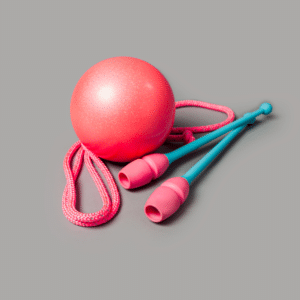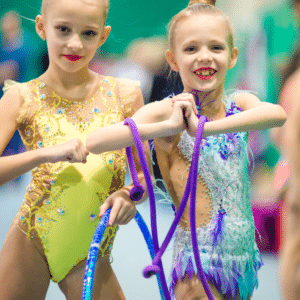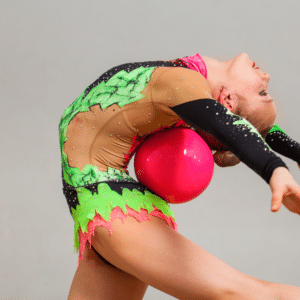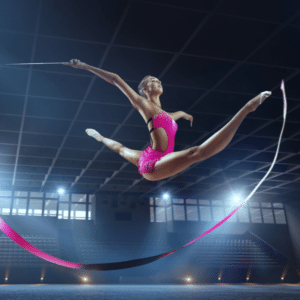Rhythmic Gymnastics is a combination of dance, gymnastics, and ballet that incorporates the use of hand-held apparatus, such as ropes, balls, hoops, clubs, and ribbons. It is a sport that requires a high level of flexibility, coordination, strength, and endurance, and is typically performed by women.
In this article, we will provide a complete guide to Rhythmic Gymnastics for beginners, including the history, benefits, equipment, basic skills, rules, and competitions.
Table of Contents
- History of Rhythmic Gymnastics
- Benefits of Rhythmic Gymnastics
- Equipment for Rhythmic Gymnastics
- Basic Skills of Rhythmic Gymnastics
- Apparatus Techniques
- Rules and Competitions of Rhythmic Gymnastics
- Conclusion
- FAQs
History of Rhythmic Gymnastics
Rhythmic Gymnastics originated in the late 19th century in Eastern Europe, where it was developed as a form of dance and exercise for women. It became an official Olympic sport in 1984, and since then, it has gained popularity around the world.
Benefits of Rhythmic Gymnastics
Rhythmic Gymnastics offers a wide range of benefits for both physical and mental health. It improves flexibility, coordination, strength, and endurance, as well as body awareness and posture. It also promotes creativity, self-expression, and confidence, and can help reduce stress and anxiety.
Equipment for Rhythmic Gymnastics
Rhythmic Gymnastics requires the use of hand-held apparatus, which includes ropes, balls, hoops, clubs, and ribbons. Each apparatus has specific requirements and techniques, and they are used to enhance the dance and gymnastic movements.

Basic Skills of Rhythmic Gymnastics
To start with Rhythmic Gymnastics, you need to learn basic skills, such as body posture, balance, flexibility, and coordination. Many of the basic shapes used in Rhythmic Gymnastics are exactly the same as in other disciplines such as Artistic or Tumbling.
You also need to master the techniques of the different apparatus, including the handling, throwing, catching, rolling, and tossing. In addition, you need to develop your artistic and expressive abilities, such as musicality, rhythm, and interpretation.
Body Posture and Balance
To perform Rhythmic Gymnastics, you need to have good body posture and balance, which are essential for executing the movements accurately and elegantly. You should keep your spine straight, your shoulders relaxed, your head up, and your feet aligned. You should also maintain a stable center of gravity, which is the point in your body where the weight is evenly distributed.
Flexibility and Coordination
Flexibility and coordination are also crucial for Rhythmic Gymnastics, as they allow you to perform the movements with grace and precision. You should stretch your muscles and joints regularly to improve your range of motion, and practice exercises that challenge your coordination and agility.
Apparatus Techniques
Each apparatus in Rhythmic Gymnastics has its own techniques and requirements, which you need to master through consistent practice and guidance. Here are some of the basic techniques for each apparatus:
Rope
The rope is a long, thick cord that is used for twirling, skipping, and jumping. You should hold the rope at its center, with your hands at shoulder width, and use your wrists and arms to create the movement. You can also wrap the rope around your body and perform different tricks and jumps.

Ball
The ball is a small, lightweight ball that is used for rolling, tossing, and catching. You should hold the ball with your fingers and palms, and use your wrists and arms to control its movements. You can also balance the ball on different parts of your body and perform various poses and jumps.

Hoop
The hoop is a circular, lightweight object that is used for spinning, rolling, and throwing. You should hold the hoop at its top, with your hands close together and use your wrists and arms to create the movement. You can also manipulate the hoop with different parts of your body and perform various tricks and transitions.

Clubs
Clubs are two long, thin sticks with weighted ends that are used for throwing, catching, and spinning. You should hold the clubs with your palms facing upward, and use your wrists and arms to create the movement. You can also perform different tricks and transitions with the clubs, such as passing them between your hands and throwing them in the air.
Ribbon
The ribbon is a long, flowing ribbon that is attached to a stick and used for waving, spinning, and dancing. You should hold the ribbon stick with one hand, and use your other hand to create the ribbon movement. You can also perform various jumps, turns, and spirals while holding the ribbon.

Artistic and Expressive Abilities
To excel in Rhythmic Gymnastics, you need to develop your artistic and expressive abilities, such as musicality, rhythm, and interpretation. You should choose music that suits your style and personality, and choreograph your routine to match the rhythm and mood of the music. You should also use your facial expressions, body language, and movements to convey emotion and tell a story.
Rules and Competitions of Rhythmic Gymnastics
Rhythmic Gymnastics has a set of rules and regulations that govern performances and competitions. In general, the routines are judged based on the technical execution, artistic impression, and difficulty level of individual skills. The judges evaluate the accuracy, precision, and creativity of the movements, as well as the overall presentation and style.
There are various types of competitions in Rhythmic Gymnastics, including individual, group, and team competitions. The athletes are grouped according to their age and skill level, and compete against each other in different categories and events. The most prestigious competition in Rhythmic Gymnastics is the Olympic Games, which is held every four years and features the best gymnasts from around the world.
Conclusion
Rhythmic Gymnastics is a beautiful and challenging sport that combines dance, gymnastics, and ballet with hand-held apparatus. It offers numerous physical and mental benefits and requires a high level of skill and dedication to excel. Whether you are a beginner or an experienced gymnast, Rhythmic Gymnastics can provide you with a unique and rewarding experience.
FAQs
Is Rhythmic Gymnastics only for girls?
Rhythmic Gymnastics is predominantly a sport for women, but there are also men’s categories in some competitions.
How long does it take to learn Rhythmic Gymnastics?
It depends on the individual’s ability and dedication, but it usually takes several months to a few years to master the basic skills and techniques.
Can you compete in Rhythmic Gymnastics without using an apparatus?
No, the use of hand-held apparatus is an essential part of Rhythmic Gymnastics.
Who are the most successful Rhythmic gymnasts?
The most successful rhythmic gymnasts include Evgeniya Kanaeva, Carolina Rodriguez and Alina Kabaeva.
What should I wear for Rhythmic Gymnastics?
You should wear a leotard or tight-fitting athletic clothing that allows you to move freely and comfortably. You should also wear appropriate footwear, such as ballet shoes or gymnastics slippers.
